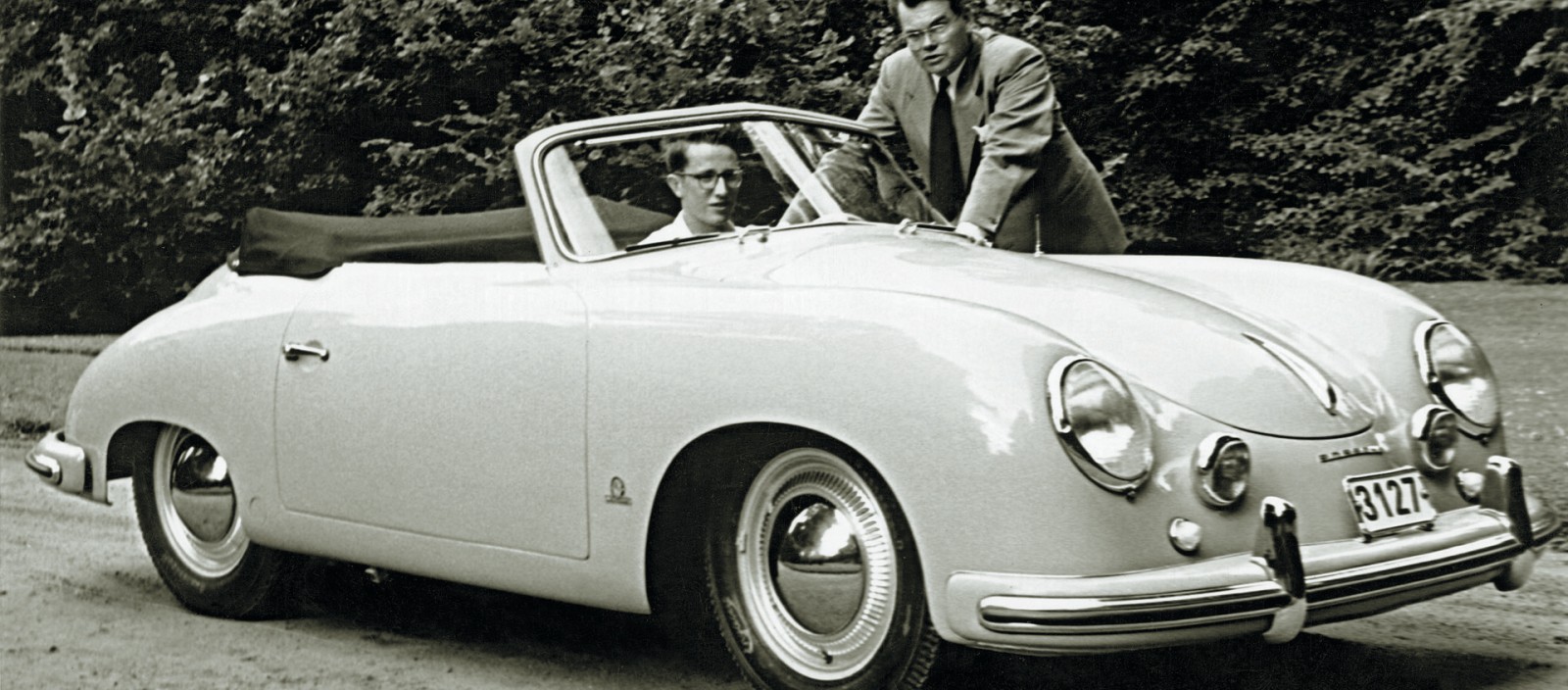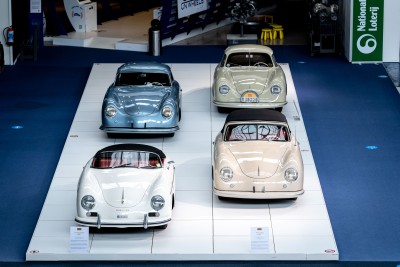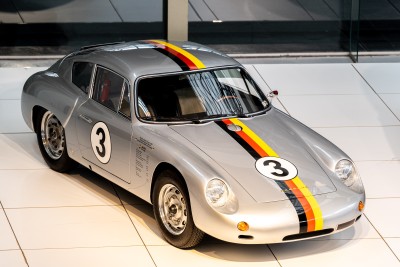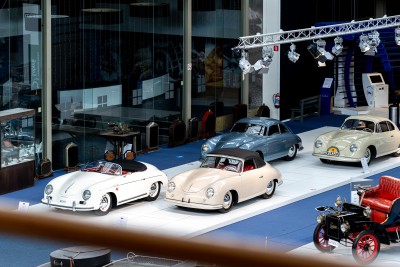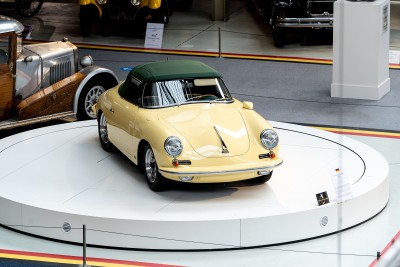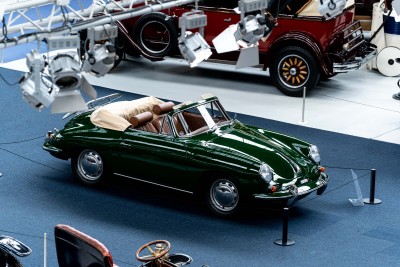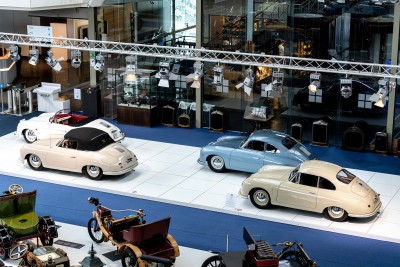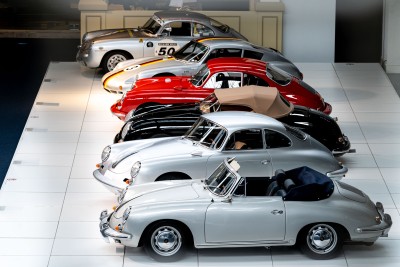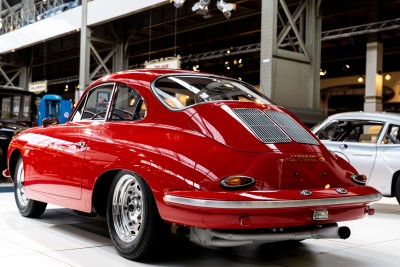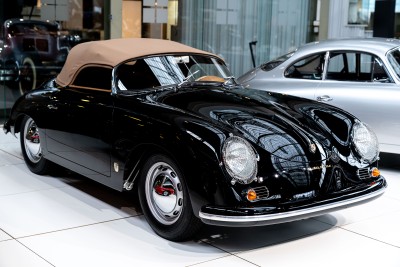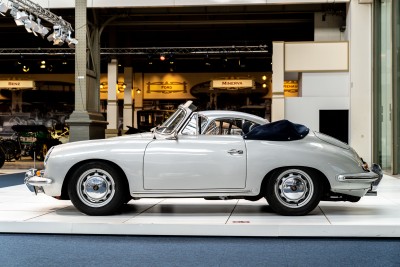Created by Ferry Porsche, Professor Ferdinand Porsche’s second son, the 356 is to first car to bear the name of what was to become a mythical make. It was at Gmünd, in Austria, that this fabulous story saw the light of day. A story that became a success….in fact a legend.This success started 70 years ago, in 1950, with the launch of this small lightweight sports car with an 1100cc flat-four air-cooled Boxer power unit. This small Porsche rapidly evolved, notably thanks to the numerous sporting successes on the major racing circuits, and in particular on the American market. To celebrate this anniversary and warm the hearts of all enthusiasts unable to bring out their pride and joy during the confinement, Autoworld will be exhibiting some fifteen models which contributed to sketching out the story of this famous and iconic sports car And, every day, a 356 will be prominently displayed in front of the museum.
A story narrated over several generations
It was during the war that Ferdinand “Ferry” Porsche and a handful of loyal employees started to develop the 356 in their workshops, a former Gmünd sawmill located in Carinthia, Austria. The first rough outlines were finished on 17th July 1947, and the following 8th June the government of Carinthia issues a special permit for the car’s homologation. Out of the fifty or so models produced in Gmünd, a mere eight are cabriolets. For each of these the construction of the bodywork and the interior was sub-contracted. Six were sent to Beutler, who gave them a slightly different shape than those emanating from the factory. The line of the rear mudguard, somewhat higher, would be retained on the following Beutler cabriolets. The dashboard is also unique. The Karosseriefabrik Ferdinand Keibl of Vienna, based on the factory’s drawings, produced a mere two units of an entirely different cabriolet.
In 1950, the production moves to Stuttgart. On the 15th June of that same year, the renowned Swedish female rally driver Cecilia Koskull wins the Midnattsssollrlallyt… For Porsche this was their first international victory – a victory that would be followed by many more.
As from that time the 356’s first name is denominated in generations A, B et C, Speedster, Roadster, Knickscheibe, Carrera… Coachbuilders such as Zagato, Denzel, Reutter, Karmann, Drauz and the Belgian D’Ieteren occasionally give the car personalised lines.
The very first 356 (also known as the “Pre-A”) is readily recognisable thanks to its split windscreen. In 1952 it is replaced by a one piece centrally curved windscreen. All generations of the 356 were also available as open versions (Cabriolet, Speedster or Roadster).In 1956 the 356 makes way for the 356 A. As from its appearance on the market this model is available with five 4-cylinder engines. The one-piece panoramic windscreen is the main visual differences between the A series and the original 356 (Pre-A). The front indicators remain integrated in the car horn grill and all models have a modified front bonnet handle incorporating the Porsche emblem. As from March 1957, the rear lights become oval. The production of the 1300 models come to an end in 1958. All generations of the 365 were also available as open versions (Cabriolet, Speedster or Convertible D).
As from 1960 the 356 A stands aside for the entirely redesigned 356 B. The major visual difference between the B series and the previous model is a front bumper with larger rosettes and raised headlights. The car horn grills next to the indicators, more prominent than earlier, are flat and decorated with two chrome strips. The bottom of the front bonnet handle is also larger. The two lamps which illuminate the rear number plate are incorporated in the rear bumper, fitted higher than the previous model, whereas the reversing light is slotted in under the bumper.The 356 C replaces the 356 B as from 1964. The number of engines is reduced to three; the 60bhp version disappears to make way for the 75 bhp unit. Visually the C series and the B series are very much alike. The last Porsche 356 C is delivered in May 1966.
In the United States Max Hoffman, the importer, is convinced that a cheaper and sportier version of the standard 356 would sell well there. With its low slanted windscreen, bucket seats and supple fold down minimalist soft top, the Porsche 356 Speedster enjoys an immediate success. In fact, the Speedster takes its cue from an American roadster, a not very popular model built by Glaser. As such Hoffman hopes to offer the car for a price of $3000. Hardly popular in Europe, the Speedster models were warmly welcomed in the United States. When the 4th last model was delivered in 1958, more than 4,000 had been sold, of which 1,234 Pre-A and 2,910 A.
It is only after the arrival of the 911, in 1963, that Porsche creates its own bodywork workshops. For the assembly of the 356’s coachwork the manufacturer calls on several sub-contractors, of which the Belgian D’Ieteren. D’Ieteren had already been assembling VW Beetle models in 1954 and Studebaker cars since 1949. In 1960 and 1961 the company produces 724 units of the Porsche 356 B Roadster, of which 300 remain in circulation thanks to the unanimously praised quality of build. Earmarked for the American market, numerous Roadster models were shipped to the importer Max Hoffman.
The D’Ieteren Roadster will preside on the revolving plateau located in the Belgian zone.
Fitted with an aerodynamic aluminium body, the 356 “Carrera Abarth” was built by Carlo Abarth in Turin, at the request of Ferry Porsche. The chassis is that of a 356 B T5, and the rear bonnet conceals a 1600 cc Carrera engine developing 115 bhp. With its 776 kg, we are looking at a true featherweight, thanks notably to its seats and door handles in aluminium, and overall some 140 kg less than the 356 Carrera GT, the latter also aimed at competition.
With its 115 bhp, the 356 Speedster Carrera GT is strongly different from the standard 60 bhp. The 1500 cc engine capacity is the same, but the renowned Führmann engine with double camshaft or “4cam“, is fitted with twin ignition and a needle bearing crankshaft (Hirth). The doors, the engine, the front bonnet and the wheel rims are in aluminium as compared to steel for the standard version.
For many years the 356 was prized by the police. The 356 T6 Polizei presented at Autoworld is one of the six original German motorway police Porsche 356 models. They were selected for their handling, their acceleration and very high-top speed. The cars were fitted with a one-off ”Polizei” engine and modified gearbox allowing them to reach far higher speeds than most of the cars at that time. They were equipped with a blue flashing light, a stop panel, a transmission system and a loudspeaker allowing the offender to be told to stop. Of this version a mere 3 models remain in this condition.
